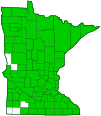American red raspberry
(Rubus idaeus ssp. strigosus)
Conservation • Wetland • Description • Habitat • Ecology • Use • Distribution • Taxonomy
Description |
||
American red raspberry is a 3′ to 7′ tall, erect bramble that rises on multiple stems from a long, perennial, underground stem (rhizome). It often forms dense colonies. It is the most widespread and often the most common tall blackberry in Minnesota. A series of biennial stems are sent up from a perennial base. First year stems (primocanes) do not flower. They grow to their full height, which can be up to 7′ long and somewhat arching near the top, but in Minnesota is usually about 3′ tall and erect. They do not arch to the ground and do not root at the tips. They are initially light green, eventually turning reddish or brownish, and are sometimes covered with a whitish, waxy coating (glaucous). They are round (not grooved), and become woody, at least near the base. They have 15 to 50 or more stiff, 1 ⁄32″ to ⅛″ long, bristly hairs per centimeter (⅜″). They do not have soft hairs or broad-based prickles. When young they also have soft, gland-tipped hairs, at least near the top. Under a hand lens these hairs look like a stalk with a ball on the end. The leaves are alternate and deciduous. Primocane leaves are palmately divided into 3 leaflets or pinnately divided into 5, rarely 7, leaflets. They are on leaf stalks that are 1⅛″ to 2⅜″ long and covered with gland-tipped hairs and stiff bristles. At the base of each leaf stalk is a small appendage (stipule) that is 3 ⁄16″ to ⅜″ long and lance-shaped, linear, or thread-like. The central stalk of the leaf is often bristly. The terminal leaflet is egg-shaped to elliptical, occasionally 3-lobed, and is on a stalk about ⅜″ long. The larger terminal leaflets are 2⅜″ to 4⅓″ long, 1½″ to 2¾″ wide. The blade is usually rounded, sometimes heart-shaped, at the base, and tapers to a point at the tip with concave sides along the tip. There are 10 to 15 lateral veins on each side of the midvein. The upper surface is dark green and initially sparsely hairy, eventually becoming hairless. The lower surface is gray-green or silvery gray due to a dense covering of grayish hairs. The margin is toothed or doubly toothed with sharp, forward-pointing teeth. The lateral leaflets are smaller, asymmetrically egg-shaped, rounded at the base, stalkless or nearly stalkless, but otherwise similar. When 5 leaflets are present, the lower two leaflets are well separated from the upper 3 by up to 1⅛″. Second year stems (floricanes) do not grow longer but develop side branches. The leaves are similar to primocane leaves but are divided into 3 leaflets, rarely 5. The leaflets are smaller and narrower. The inflorescence is a dense, flat-topped or convex, often drooping cluster of 3 to 7 flowers at the ends of the stems and branches. The stalked flowers in the cluster grow upward from various points on the main stem to approximately the same horizontal plane (corymb). Sometimes there are also 1 or 2 flowers rising from upper leaf axils. The stalk of the cluster and the stalks of the individual flowers are bristly have numerous gland-tipped hairs. The flowers are 5 ⁄16″ to ½″ across and are not showy. There are 5 green, 3 ⁄16″ to ⅜″ long sepals. They are triangular to lance-shaped, hairy, erect to spreading when in flower, eventually bent backward when in fruit. There are 5 white, elliptical, ⅛″ to ¼″ long, erect petals. The petals are shorter than the sepals. There are many stamens, all shorter than the petals. The flowers appear in late May to early July. The fruit is a bright red, juicy, short, almost globe-shaped, ½″ to ⅝″ in diameter aggregate of multiple drupelets. It matures mid-July to late August. When picked it separates easily from its core. It is smaller but tastier than the domestic raspberry. |
||
Height |
||
3′ to 7′ |
||
Flower Color |
||
White petals, green sepals |
||
Similar Species |
||
Allegheny blackberry (Rubus allegheniensis) leaves are palmately lobed. European red raspberry (Rubus idaeus ssp. idaeus) is a similar European species that lacks gland-tipped hairs on first-year canes, leaf stalks, flower stalks, and calyces. The leaves are pinnately divided into 5 or 7, rarely 3, leaflets. It sometimes escapes gardens but is not naturalized. Black raspberry (Rubus occidentalis) is a larger plant. The canes can get much longer, up to 13′. Longer canes arch to the ground and root at the tip. They have broad-based prickles and no bristles. The fruits ripen purplish-black, not red. |
||
Habitat |
||
Dry to moist. Forests, forest margins, woods, thickets, lake shores, meadows, roadsides. Full sun to partial shade. |
||
Ecology |
||
Flowering |
||
Late May to early July |
||
Pests and Diseases |
||
Raspberry fruitworm beetle (Byturus unicolor) adults feed voraciously on the emerging leaves, creating many elliptical holes in the foliage. Their feeding sometimes causes developing bud clusters to be aborted. The larvae feed on the fruit, creating dry, decaying berry drupelets. |
||
Use |
||
|
||
Distribution |
||||
|
Sources |
|||
| 2/14/2023 | ||||
Nativity |
||||
Native |
||||
Occurrence |
||||
Common and widespread |
||||
Taxonomy |
|||
| Kingdom | Plantae (Plants) | ||
| Subkingdom | Pteridobiotina | ||
| Phylum | Tracheophyta (Vascular Plants) | ||
| Class | Magnoliopsida (Dicots) | ||
Order |
Rosales (Roses, Elms, Figs, and Allies) | ||
Family |
Rosaceae (Rose) | ||
| Subfamily | Rosoideae (Brambles, Roses, Strawberries, and Allies) | ||
| Tribe | Rubeae (bramble) | ||
Genus |
Rubus (brambles) | ||
| Subgenus | Idaeobatus | ||
| Section | Idaeanthi | ||
| Species | Rubus idaeus (European raspberry) | ||
There is some disagreement about the classification of this plant. Most sources, including GRIN, NCBI, UniProt, Plants of the World Online (POWO), World Flora Online, iNaturalist, NatureServe, and the Minnesota DNR (MNTaxa) list it as Rubus idaeus ssp. strigosus. ITIS lists it as Rubus sachalinensis var. sachalinensis. Wikipedia lists it as the species Rubus strigosus. |
|||
Subordinate Taxa |
|||
|
|||
Synonyms |
|||
Rubus carolinianus Rubus idaeus var. aculeatissimus Rubus idaeus var. canadensis Rubus idaeus var. gracilipes Rubus idaeus var. melanolasius Rubus idaeus ssp. melanolasius Rubus idaeus var. melanotrachys Rubus idaeus ssp. sachalinensis Rubus idaeus ssp. strigosus Rubus idaeus var. strigosus Rubus melanolasius Rubus neglectus Rubus strigosus Rubus strigosus var. acalyphaceus Rubus strigosus var. arizonicus Rubus strigosus var. canadensis |
|||
Common Names |
|||
American red raspberry common red raspberry grayleaf raspberry grayleaf red raspberry North American red raspberry red raspberry wild red raspberry |
|||
Glossary
Aggregate fruit
A compound fruit consisting of many separate individual fruits derived from separate ovaries in a single flower, like a raspberry or blackberry.
Axil
The upper angle where a branch, stem, leaf stalk, or vein diverges.
Bramble
Thorny plants in the genus Rubus, including blackberry, dewberry, and raspberry.
Corymb
A flat-topped or convex inflorescence in which the stalked flowers grow upward from various points on the main stem to approximately the same horizontal plane. The outer flowers open first.
Drupe
A fleshy fruit with a single hard, stone-like core, like a cherry or peach.
Floricane
A two year old cane of a raspberry or blackberry that bears fruit and then dies.
Glandular hairs
Hairs spread over aerial vegetation that secrete essential oils. The oils act to protect against herbivores and pathogens or, when on a flower part, attract pollinators. The hairs have a sticky or oily feel.
Glaucous
Pale green or bluish gray due to a whitish, powdery or waxy film, as on a plum or a grape.
Linear
Long, straight, and narrow, with more or less parallel sides, like a blade of grass.
Palmate
Similar to a hand. Having more than three lobes or leaflets that radiate from a single point at the base of the leaf.
Pinnate
On a compound leaf, having the leaflets arranged on opposite sides of a common stalk. On a bryophyte, having branches evenly arranged on opposite sides of a stem.
Primocane
The first year cane of a raspberry or blackberry; it is usually unbranched and normally does not flower.
Rhizome
A horizontal, usually underground stem. It serves as a reproductive structure, producing roots below and shoots above at the nodes.
Sepal
An outer floral leaf, usually green but sometimes colored, at the base of a flower.
Stipule
A small, leaf-like, scale-like, glandular, or rarely spiny appendage found at the base of a leaf stalk, usually occurring in pairs and usually dropping soon.
Visitor Photos |
|||||
Share your photo of this plant. |
|||||
| This button not working for you? Simply email us at info@MinnesotaSeasons.com. Attach one or more photos and, if you like, a caption. |
|||||
|
|||||
MinnesotaSeasons.com Photos |
|||||
Plant |
|||||
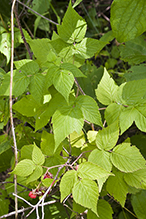 |
|||||
Leaves |
|||||
 |
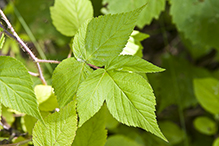 |
||||
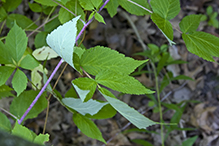 |
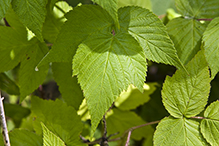 |
||||
Stem |
|||||
 |
|||||
Infructescence |
|||||
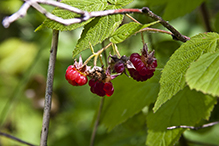 |
|||||
Fruit |
|||||
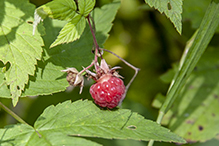 |
|||||

Slideshows |
||

Visitor Videos |
|||
Share your video of this plant. |
|||
| This button not working for you? Simply email us at info@MinnesotaSeasons.com. Attach a video, a YouTube link, or a cloud storage link. |
|||
Other Videos |
|||

Visitor Sightings |
|||||
Report a sighting of this plant. |
|||||
| This button not working for you? Simply email us at info@MinnesotaSeasons.com. Be sure to include a location. |
|||||
|
|||||
MinnesotaSeasons.com Sightings |
|||||
Badoura Jack Pine Woodland SNA Carpenter St. Croix Valley Nature Center Charles A. Lindbergh State Park Clifton E. French Regional Park Felton Prairie SNA, Bicentennial Unit Forestville/Mystery Cave State Park Itasca Wilderness Sanctuary SNA John Peter Hoffman Spring Brook Valley WMA Lake Alexander Woods SNA, South Unit Margherita Preserve-Audubon Prairie Mary Schmidt Crawford Woods SNA Mound Spring Prairie SNA, North Unit Nerstrand Big Woods State Park Northern Tallgrass Prairie NWR, Rengstorf Unit P.N. and G.M. Nelson Wildlife Sanctuary Pembina Trail Preserve SNA, Crookston Prairie Unit Sand Prairie Wildlife Management and Environmental Education Area |
|||||

|
Created: Last Updated: © MinnesotaSeasons.com. All rights reserved. |
